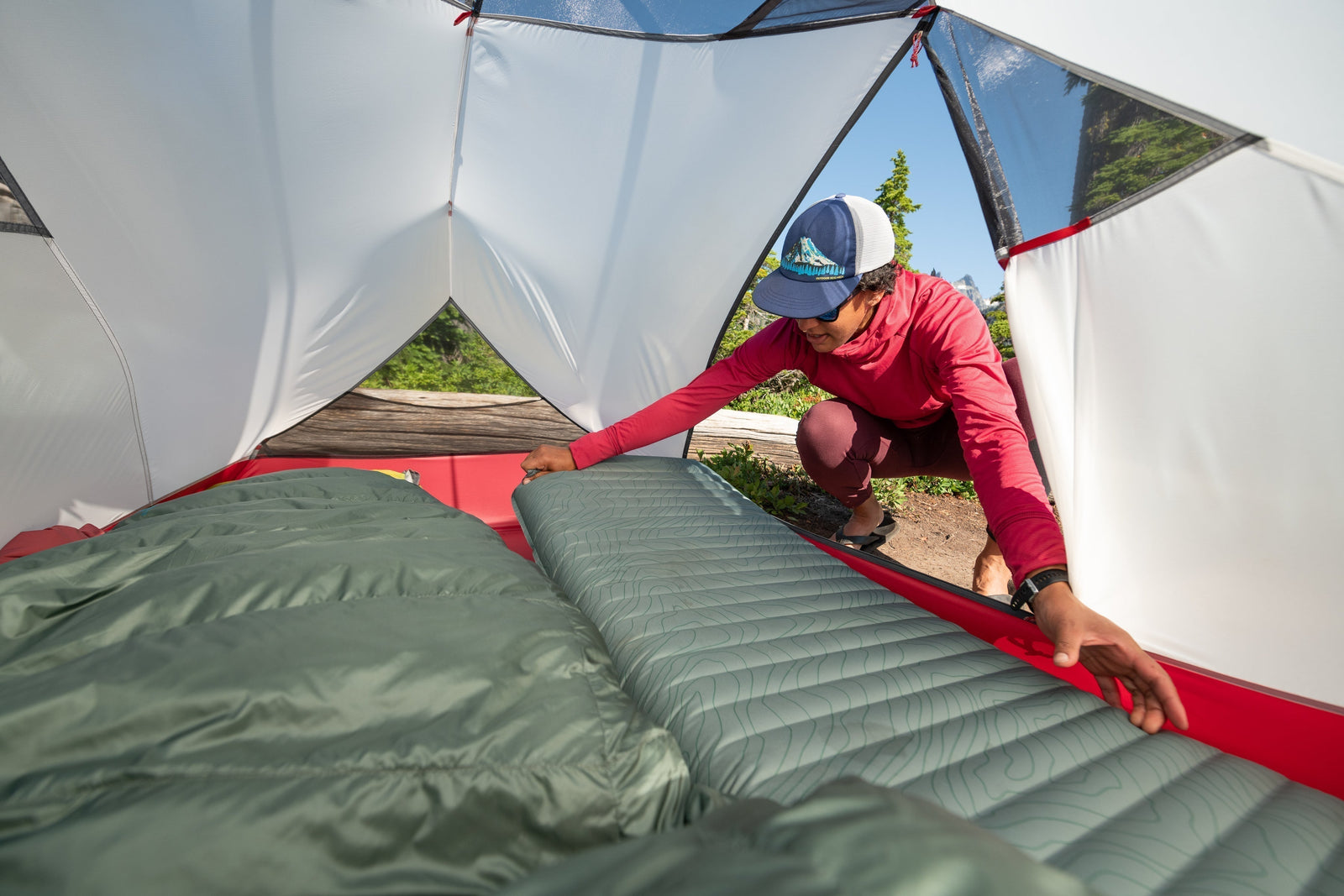If you’re reading this article, you probably feel, like me, that riding a motorcycle is something approaching magic—miles of road and trail melting away beneath your wheels, the roar of the engine in tune with the flick of wrist and toe, the bike responding to every lean like an extension of your body.
Motorcycle camping takes all this, and blends it with the grounding connection of the wilderness. You pull up to a secluded spot, watch the sunset paint the sky crimson, and get ready for a chill night under the stars…
Only to wake up in the wee hours of the morning with a stabbing pain in your neck, a rock poking into your hip, a numb leg, and a half-deflated camping mattress. If you’ve ever found yourself in this situation (or if the above description freaked you out enough that you never want to) then I have written the following guide for you.
(NOTE: The pad in the lead image is a Therm-a-Rest Neo Air)
What Does a Sleeping Pad Do?
When it comes to camping, everyone knows about sleeping bags. Much thought and debate and hooha goes into selecting the correct sleeping bags, with the right temperature rating, design, and style of filling. (I used to work for a sleeping bag company, so I am intimately familiar…)
But many campers forget the humble sleeping pad!
This is a shame, because at the end of the day, your sleeping bag may keep you warm, but it’s your sleeping pad that keeps you comfortable. (Sleeping pads do a lot to keep you warm, too, by providing a layer of thermal insulation between you and the ground.) In fact, when it comes to getting a good night’s rest while camping, sleeping pads do at least 70% of the work, if not more.
Sure, many of us have snoozed on empty trash bags and hardwood floors, using crumpled beer cans as pillows. But those were our 18-year-old bodies…
As adult moto campers, a comfortable sleeping pad is a necessity. And given that every square inch and ounce counts when packing a motorcycle, selecting your pad requires careful consideration. You have to balance comfort, durability, weight, packed size, and price.
Types of Sleeping Pads
Excluding cots and hammocks, there are three main types of sleeping pads used in camping:
Air Pads: These offer the highest potential comfort and can pack down incredibly small. Many are lined with internal baffles or reflective materials for impressive insulation (see “R-Value” below). The only real downside to air pads (besides price) is punctures. A patch kit is an essential companion!
Closed-Cell Foam Pads: These pads are made from dense foam that is tightly packed with small, sealed-off air pockets. Closed-cell foam pads are virtually indestructible, light, and cheap. They provide solid insulation, but minimal cushioning. And although they are light, they are quite bulky, often needing to be strapped to the outside of a pack.
Open-Cell Foam (Self-Inflating) Pads: Combining air with foam padding, these offer a balance of comfort, insulation, and durability. Unlike closed-cell pads, these have an internal foam core, with an airtight shell around it. When you lay out your pad and open the inflation valve, the foam will expand and air is naturally drawn in. Self-inflating pads are heavier and bulkier than air pads, but are generally less susceptible to punctures. (NOTE: You may have to top the pad off yourself with a bit of blowing, but it won't be nearly as much huffing and puffing as a normal air pad.)
Shop Sleeping Pads
For most motorcycle campers seeking the best blend of comfort and packability, an air pad is the best choice. They’re lighter, smaller, and more comfortable than foam and self-inflating pads. Just treat them with care to avoid punctures.
That said, the gold standard is to stack an air pad like the EXPED Ultra 5R on top of a cheap, closed-cell foam pad. The foam pad will act as a base layer to protect your air pad from rocks and sticks (which can cause punctures), and you’ll get double the comfort and insulation. This is the method I use for long-haul mountaineering trips, when I want to be sure to protect my air pad for days or weeks of camping.

Sleeping Pad Metrics
Let’s cover the main measurements you need to know about your sleeping pad: length, width, R-value, packed size, weight, and thickness.
Length
Most sleeping pads come in regular (~72 inches) and long (77 to 80 inches) sizes. The goal is to have both your head and heels comfortably on the pad. If you're taller, a long pad prevents your feet from dangling off and getting cold. Shorter campers can save a little weight and bulk with a regular (or even three-quarter length pad), using a pack or clothes to prop their feet up. However, full coverage offers maximum comfort.
Width
Standard (narrow) sleeping pads are 20 inches wide. For back sleepers who don't move much, this might suffice. However, if you toss and turn, sleep on your side, or simply prefer more space, a medium (25”) or wide (30”) pad can dramatically improve sleep quality, by keeping your arms and shoulders from slipping off onto the ground.
The slight increase in packed size and weight are often a worthy trade-off for enhanced comfort. Keep in mind that some brands will have their 25-inch pads labeled “wide,” while for others that will be a standard size. Our comparison chart is based on a brand standard of 25” wide to 72” long.
R-Value
A sleeping pad provides cushioning for comfort, but it serves a second purpose too, insulating you from the cold ground (which can suck warmth away surprisingly fast). The key metric in this latter function is a pad’s R-value, which denotes its thermal resistance (how well it prevents heat from flowing through it).
So, a higher R-value = better insulation. For summer camping, an R-value of 2 to 4 is fine. For most three-season moto camping trips, an R-value between 3 and 5 offers a good balance of warmth, weight, and pack size. If you venture into winter, an R-value of 5 or higher is recommended.
Packed Size / Volume
As motorcyclists, we have to pack our gear small and tight, and sleeping pads are no different. The vertical axis on the Moto Camp Nerd comparison chart shows the packed size (inches by inches) or volume (liters) of some of the main sleeping pads we sell here.
Usually (but not always) the larger the pad, the more comfortable it will be. On the low end, we have ultra-minimalist pads like the Tensor Elite UL, which is just 5.5” x 3” (0.64L). On the high end, we have beefy pads like the EXPED Dura 8R.
NOTE: Higher pad volume doesn't always equal more insulation. See the NEMO Tensor Extreme, for example, which is only 2.74L but has a bomber 8.5 R-rating.
Weight
The horizontal axis of our comparison chart shows a pad’s weight. On the low end, you’ll have lightweight pads weighing less than a pound (16 ounces), on the high end, comfort-focused pads that can weigh up to 38 to 40 ounces. (For reference, that’s about the weight of a full one-liter Nalgene water bottle.)
Thickness
Sleeping pad thickness is a good way to get an idea of how comfortable your pad will be, but it’s not as useful of a metric as you might think. Many cheap, thick pads aren’t very comfortable, and many thin pads can feel like sleeping on a cloud. Two to three inches is a good minimum for a sleeping pad. Higher performance pads are typically 3.5 to 4.5 inches.

Inflating Your Sleeping Pad
Most basic air pads rely on mouth inflation. In other words, you blow into the thing until it inflates. Instead of huffing and puffing, use long, slow and steady breaths. While this method is simple and requires no additional gear, it does introduce moisture into the pad via your breath, which can degrade a pad’s insulation over time, and promote mold.
To avoid this, pump sacks—sealed bags that you wave around, capturing air, and then compress to push the air into your pad—are another lightweight, popular solution. (All sleeping pads we stock here at Moto Camp Nerd come with a pump sack!)
Pump sacks are the cheapest, lightest, and most efficient inflation method (and this author's preferred solution), but there are a few other methods. Some pads have integrated hand or foot pumps. There are also compact, battery-operated electric pumps like this one from EXPED or this one from Big Agnes, which offer effortless inflation at the cost of extra weight. If you’re inflating multiple pads, electric pumps can be a nice aid.
Don’t Forget a Pillow!
Anyone who has ever actually slept on a dedicated camping pillow will tell you… those suckers make a difference!
At first, jamming a jacket into a stuff sack may seem like a space-saving hack, but it usually just results in a lumpy, unsupportive headrest—a one-way ticket to abominable neck pain.
We may cover pillows in depth in a guide later, so I won’t go into too much detail here, but long story short, investing in a camping pillow will dramatically improve your sleep quality, and with minimal drawbacks in weight and space.
Inflatable pillows pack down to almost nothing, and allow you to customize firmness. Look for designs with soft, fabric surfaces for better comfort. Compressible pillows, filled with foam or synthetic materials, feel more like your pillow at home, but take up more space. Don't dismiss this small item—proper head and neck alignment is fundamental to restful sleep.
Shop Camping Pillows
-----
Owen Clarke (@opops13) is an American action sports journalist. A longtime contributor to Climbing and Rock and Ice magazines, he has also written for Iron & Air, Outside, and Travel + Leisure, among other titles. In addition to his work with Moto Camp Nerd, Owen is a contributing editor for Summit Journal and the American Alpine Journal's Africa editor.

